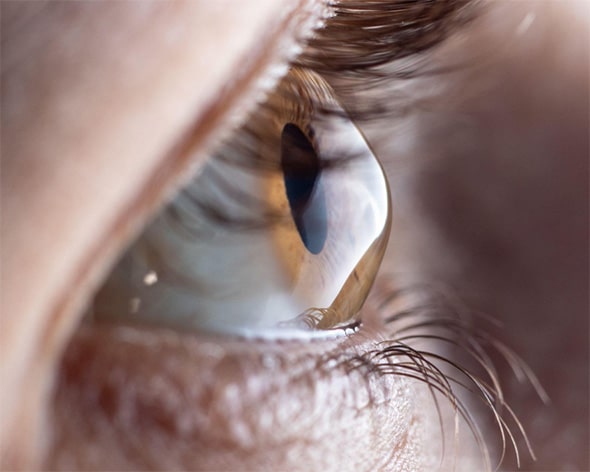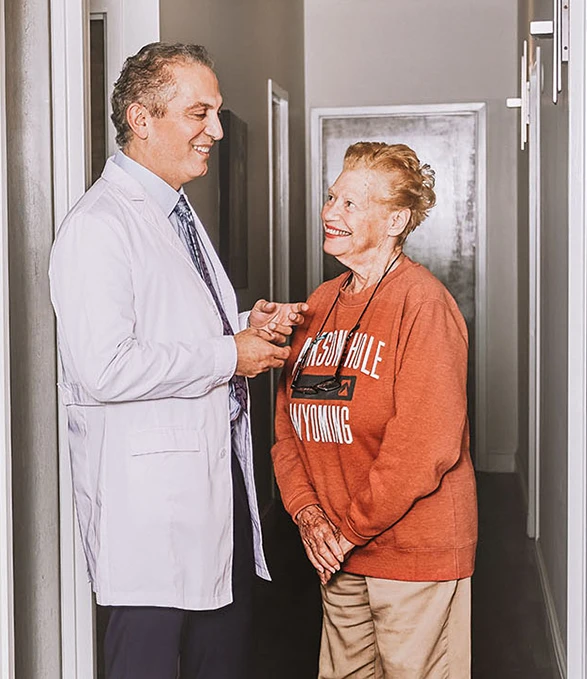PRK is a procedure that has helped millions of people worldwide gain independence from glasses. It uses a laser to reshape the surface of the cornea. The cornea is the clear dome in front of your eye and acts as a lens that focuses the light into the eye.
Patients with a wide range of conditions like myopia, hyperopia and astigmatism have benefitted from PRK in the last 25 years. Recently, a new form of PRK known as topography-guided PRK offers hope to millions of patients with other eye conditions that couldn’t see well even with glasses or soft contacts. The goal of these patients is to see better, period. Such conditions include keratoconus, keratoectasia, irregular astigmatism and post-corneal transplant patients.

An eye with a distorted cornea due to keratoconus
Topography-guided PRK is a type of laser vision correction that leverages the power of advanced mapping technology to create a precise and comprehensive three-dimensional map of the cornea. This map, known as a topography, provides a detailed representation of the cornea’s surface and shape, allowing the PRK surgeon to tailor the laser correction to the individual needs of each patient.
In comparison, traditional LASIK is based on the patient’s eyeglass prescription, which provides only a general understanding of the cornea’s shape and fails to take into account the many subtle variations and imperfections that can impact vision. With topography-guided LASIK, the laser correction is guided by the comprehensive topography map, which includes thousands of data points providing a more effective and personalized approach to vision correction. This approach results in a sharper vision and lowers the incidence of side effects like glare and haloes.
Keratoconus: Patients who have keratoconus and have already performed CXL (Collagen Cross-Linking) could benefit from this procedure greatly. Keratoconus causes irregular astigmatism that cannot be fixed by glasses or soft contact lenses and cannot be corrected with traditional LASIK or PRK. Traditional LASIK/PRK can correct only myopia, hyperopia or regular astigmatism in the same fashion that these conditions could be corrected with glasses or contacts based on a prescription. However, topography-guided PRK is not based on the limited and uniform data provided by the prescription but on the topography map and its thousands of data points.
LASIK complications: Another group of patients who may benefit from topography-guided PRK are patients that had complications from LASIK surgery that did not go well and are unhappy with the outcome. Those complications include but are not limited to: corneal scarring, flap complications, central island etc. Dr. Cohen has helped many such patients regain excellent vision.
Irregular astigmatism: Some patients may have other conditions that cause irregular astigmatism. This is another example where topography-guided PRK can help.
Post-corneal transplant patients: Patients who already had a corneal transplant often have high degrees of irregular astigmatism. Topography-guided PRK can provide a safe and effective solution for these patients and improve their vision.

The first step in topography-guided PRK is the creation of a topography map of the cornea. This is done using a corneal topographer, a device that projects light patterns onto the cornea and records the reflection of these patterns using cameras. The information gathered is then used to create a highly detailed map of the cornea’s shape and surface. Dr. Cohen uses the most advanced topographer called the “Topolyzer” for this purpose. Unlike other topographers, this device was designed specifically for topography-guided PRK.
Once the topography map is complete, the PRK procedure begins. The cornea is gently ablated using an excimer laser to remove small amounts of tissue and reshape the cornea. Unlike LASIK, PRK does not require the creation of a flap in the cornea, making it an ideal option for those who are not suitable candidates for LASIK due to a thin cornea or other factors.
The laser correction is guided by the topography map, ensuring that the treatment is customized to the specific needs of each patient. Dr. Cohen uses the Allegretto 500 Wavelight device for this purpose. This is one of the most advanced laser platforms today and works flawlessly with data provided by the “Topolyzer”. The healing period is typically 4-7 days, but it may take up to a few weeks to realize the full visual benefit.
There are several notable benefits of topography-guided PRK, including:
Customized Correction: One of the primary advantages of topography-guided PRK is the level of customization it provides. By using the topography map to guide the laser correction, the treatment is tailored to the specific needs of each patient, leading to a more effective and personalized outcome.
Improved Accuracy: The use of topography mapping allows for a more accurate and precise laser correction, reducing the risk of complications and ensuring optimal results.
Better Results for Complex Cases: Traditional PRK can be less effective for patients with complex corneal shapes or other vision problems, such as high levels of astigmatism. Topography-guided PRK, on the other hand, can provide better results for these complex cases, resulting in clearer and sharper vision.
Reduced Risk of Complications: By using the topography map to guide the laser correction, topography-guided PRK minimizes the risk of complications such as halos, glare, and starbursts.

Speak to your eye care provider about topography-guided PRK to see if this is a good option for you.
Dr. Cohen is a fellowship-trained cornea specialist and has devoted his career to fine-tuning and perfecting surgical techniques that can change your vision and your life. This is perhaps the reason that more than 1,000 physicians have chosen him for the correction of their own vision.
2024 Cohen Eye Institute. All rights reserved.